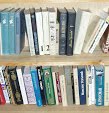
Every now and then
—maybe once a year or so
—I read a book
that gives me a fleeting case of PhD program dropout remorse syndrome. I like,
no, I love, the book, see its value for a broader readership, and begin
designing courses and creating syllabi in my head so I can force (okay,
attempt to force…) a group of
unsuspecting but curious undergraduates to read, appreciate, and love it, too. “Fleeting”
means the syndrome usually disappears within a few minutes, after I’ve
remembered how much I hate grading, office hours nobody comes to, and academic
paperwork. Besides, I have a completely painless outlet for some of those
urges: some of you occasionally ask me for book ideas for your courses.
I’m sure you can see where this is going: I read
Soviets by Danzig Baldaev and Sergei
Vasiliev and would love to put it on someone’s reading list.
Soviets is my second book from Fuel, a
London-based publisher. The first was Baldaev’s
Drawings from the Gulag, which I
called
“a deeply disturbing book that documents, through detailed drawings and concise
captions, the horrors of the Soviet Gulag system.”
Soviets isn’t nearly as disturbing, though many of Baldaev’s dozens
of angry caricatures and commentaries on life in Sovietdom are uncomfortable
and grotesque, addressing subjects like anti-Semitism, alcoholism, and the
Afghan War.
Soviets juxtaposes Baldaev’s
work with photos by Sergei Vasiliev, a photographer who worked for
Vecherny Chelyabinsk. Like
Drawings,
Soviets is bilingual (this is great for students!), with
English-language translations from Polly Gannon and Ast A. Moore.
Soviets covers so
much that it’s hard to summarize its value for students of Soviet-era or
post-Soviet Russian literature and culture. For someone like me, a life-long
learner in the field who lived for an extended period in 1990s Russia, (and
admittedly has trouble making it through book-length nonfiction), the broad
range of figures in Baldaev’s drawings and Vasiliev’s photos—the former draws
everyone from a barfing drunk to a medal-covered Brezhnev, and the latter
photographs everyone from soldiers meeting Yuri Gagarin to female prisoners
“volunteering” on their day off—goes a long way toward filling in gaps on aspects
of Soviet life that I never had a chance to witness or learn about. Things like
scientists sorting vegetables in a storage facility or the name
Нихухрымухрыниксы (transliterated:
Nikhukhrymukhryniksy, which the book calls “a portmanteau of
ne khukhry-mukhry (‘not to be sniffed at’) and the
Kukryniksy – three satirical
cartoonists who signed their work collectively under this name.” Kukryniksy drawings
were published in the Soviet magazine
Krokodil.
“The fifth column,” a term that’s making a comeback these days, also appears in
Soviets.
I should add that many of the panels in
Soviets include explanatory notes. Randomly opening—this was a
fortuitous opening to a particularly rich panel—brings up a page depicting tiny
people being emptied into a Belomorkanal cigarette carton by the NKVD and an
ashtray bearing the saying “
Лес
рубят – щепки летят” and holding what looks to be a heap of people. This
page includes a reference to poet Osip Mandelstam with a brief note about his
life, work, arrest, and death plus a note about
Belomorkanal cigarettes,
created to commemorate the construction of the canal between the White and
Baltic Seas. The saying on the ashtray, by the way, is rendered as “You can’t
make an omelette without breaking eggs,” which is certainly more familiar and,
thus, clearer to casual readers than something more literal, like “If you cut
down trees/forests, sawdust flies,” something I’d never really thought much
about until sawdust really did fly in my backyard last week on a breezy day.
Many pages of
Soviets also
contain quotations from works about the Soviet Union that complement the topic
in the drawing. The book endeared itself to me even more when I found a quote
from
The Soviet Union: empire, nation,
and system, by
Aron Katsenelinboigen, whose course in Soviet geography
taught me more about the Soviet system than all my other college courses
combined. He’s quoted on a page about alcohol, workers, and payment, noting
that workers were sometimes compensated in pure alcohol, measured by the glass.
The bibliography in
Soviets contains
around 30 items. From a to z, they start with Martin Amis’s
Koba the Dread and end with Aleksandr
Zinovyev’s
Homo-Sovieticus.
And then there are Vasiliev’s photos, all black and white,
many depicting official parades, sporting events, and workers. They make a
beautiful complement to Baldaev’s drawings, particularly because it’s often
difficult to decide which angle on Soviet reality feels more realistic. Or
absurd. I’m sure part of the reason the spectral double-paged picture of a long,
long line for Lenin’s mausoleum on a snowy day particularly struck me: I went
to the mausoleum in 1983 and was nearly denied entry because I was wearing
sandals. Disrespectfully open sandals. There’s also the contrast of an tubercular
inmate who has a Lenin tattoo on his shoulder, and, later in the book, five
nude sunbathing women on a roof in Chelyabinsk in 1976. The shadows are lovely. The
ethereal photo across from that one shows a woman bathing her son in a small
washtub on a roof; it looks like there’s a clothesline, too, and a breeze. It’s 1977.
The Fuel Web site offers some sample pages from
Soviets,
here. The photographs include
the afore-mentioned photo of the line to Lenin’s mausoleum.
Disclaimers: The usual.
Thank you very, very much to Fuel for sending me a review copy of
Soviets.
Up Next: Yuri
Mamleyev’s The Sublimes. Later still,
Mikhail Bulgakov’s White Guard, which
I like very, very much but find slow going. Also, Irina Ratushinskaya’s The Odessans. And a trip report on
BookExpo America, which is coming up at the end of the month and will feature a
day-long program about translated literature.


